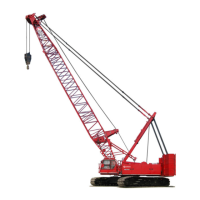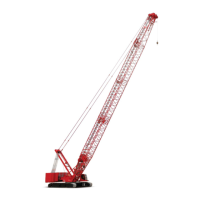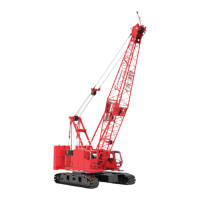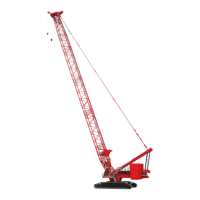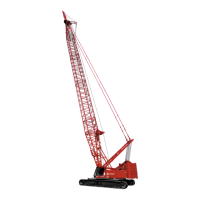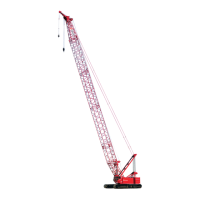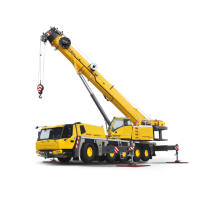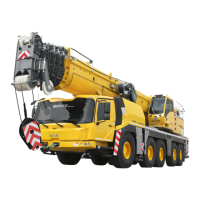Do you have a question about the Manitowoc MLC100-1 and is the answer not in the manual?
| Brand | Manitowoc |
|---|---|
| Model | MLC100-1 |
| Category | Construction Equipment |
| Language | English |
Provides specific data about the crane, including basic specifications and EC declarations.
Details the various weights of the crane and its components for handling and transport.
Presents the overall physical dimensions of the crane for planning purposes.
Instructions for new owners to register their crane for service and support.
Information on how to contact a Manitowoc dealer for questions or assistance.
Explains how to locate the crane's model and serial number on the identification plate.
Defines terms like front, rear, left, and right relative to the operator's position.
Illustrates and lists key components of the crane with their corresponding numbers.
Provides tables for converting between English and metric units for various measurements.
Explains the use of safety alert symbols and signal words to convey hazard severity.
Details the importance of maintaining legible and properly installed safety signs on the crane.
Discusses safe access points, keeping them clear, and general safety precautions for getting on/off the crane.
Provides specific instructions on how to safely climb onto or off the crane, emphasizing when it's parked.
Outlines the owner/user's responsibility for providing appropriate fall protection equipment for personnel.
Explains the importance of storing operator manuals and capacity charts in the cab for easy access.
Details general safe operating principles, operator qualifications, and conduct requirements for crane operation.
Covers safe practices for lifting and moving loads, including size limitations and attachment procedures.
Explains standard hand signals and audible signals used for crane operations and communication.
Lists safety devices provided on the crane and procedures if they are not working properly.
Describes operational aids, their categories, and requirements when they are not working properly.
Provides critical safety guidelines for working near electrical hazards to prevent electrocution.
Details the dangers of electrocution and strict precautions required when working near power lines.
Explains the limitations of safety devices and the importance of following procedures even when they are installed.
Outlines immediate actions to take if the crane contacts an energized power source.
Provides safety guidelines for refueling the crane to prevent fires and hazards.
Specifies the type of fire extinguisher required and the importance of familiarity with its use.
Details the procedure for reporting accidents involving property damage or personal injury.
Emphasizes the importance of safe maintenance practices and personnel qualifications.
Details that maintenance must be performed by qualified personnel following manual instructions.
Lists essential steps to take before starting any maintenance procedure on the crane.
Illustrates and describes standard hand signals used for crane operations, compliant with ASME B30.5.
Identifies symbols used on control consoles to help operators understand control functions and operations.
Provides a visual overview and description of the various controls and indicators located in the operator's cab.
Instructions for operating cab windows for ventilation and emergency exit procedures.
Explains how wind affects crane stability and lifting capacity, and procedures for operating in windy conditions.
Details requirements and procedures for blocking crawlers to prevent tipping during boom operations.
Outlines essential checks and procedures to perform before starting crane operations.
Step-by-step guide for safely starting the crane's engine and initial system checks.
Detailed instructions on how to operate the boom hoist control for raising and lowering the boom.
Explains the procedure for operating the swing function, including speed control and safety precautions.
Instructions for operating load drums in full power mode for lifting and lowering loads.
Details the procedure for engaging and operating the free fall function for load drums.
Instructions for operating the crane in clamshell mode, including bucket operations and preparation.
Provides comprehensive guidance on safe travel procedures, including route planning and crawler operation.
Outlines the correct procedure for safely shutting down the crane and leaving it unattended.
Describes the procedure and configurations for traveling the crane with low clearance requirements.
Provides essential information and precautions for operating the crane in cold weather conditions.
Refers to drawings at the end of the section for boom and jib assembly instructions.
Indicates where to find lifting capacity information for the boom butt.
Defines terms like front, rear, left, and right relative to the operator's position.
Discusses safe access to crane parts during assembly and disassembly, highlighting fall hazards.
Emphasizes that assembly and disassembly must be done by experienced personnel familiar with the manual and drawings.
Provides guidance on safely handling crane components using lifting lugs and slings.
Explains various methods used to retain connecting pins and stresses the importance of proper installation.
Refers to Section 1 for crane weights and shipping dimensions of components.
Describes the parts box provided and its contents, as well as storage options for optional equipment.
Details how to store the optional position light and anemometer assembly during transport.
Shows the crane's configuration for shipping and provides shipping weights and dimensions.
Lists components that enable the crane to assemble and disassemble itself.
Identifies the controls for crane assembly/disassembly located on the remote control and in the cab.
Emphasizes cleaning and greasing pins and connecting holes to prevent damage.
Stresses the importance of cleaning electric connectors and dust caps to prevent faults and damage.
Outlines safety procedures for connecting/disconnecting hydraulic lines and electric cables, emphasizing engine shutdown.
Lists essential checks to perform before starting the engine, including fluid levels and leak checks.
Provides procedures for assembling the crane, starting with preparing the trailer and deploying steps/platforms.
Steps to prepare the trailer for unloading the crane, including positioning and deck lowering.
Instructions for deploying the crawler steps from their stored position to the working position.
Steps for deploying crane platforms to access different areas of the crane during assembly.
Instructions for preparing the operator cab, including cab cover removal and mirror adjustment.
Details the procedure for raising handrails from their stored position to the working position for safety.
Procedure to start the crane's engine after completing pre-start checks.
Instructions to select and confirm the correct crane configuration in the RCL/RCI display.
Steps to raise the gantry, including using the gantry cylinders and boom hoist wire rope.
Procedure for safely moving the crane off the transport trailer.
Detailed instructions for extending the crane's crawlers, including cleaning, lubrication, and shim installation.
Instructions for installing the hook-and-weight ball onto the boom butt, including load line routing.
Describes how the crane is used to unload trailers, referencing boom butt capacities.
Guidance on handling boom sections, emphasizing care and use of appropriate lifting slings.
Instructions for handling jib sections, noting they do not have lifting lugs and require specific sling use.
Information on lifting points for counterweight boxes and trays and the use of supplied lifting slings.
Outlines methods for assembling the boom and jib using the crane's boom butt or an assist crane.
Step-by-step procedure for installing carbody counterweight, including safety precautions.
Instructions for assembling the crane counterweight using lifting slings and connecting pins.
Continues the procedure for installing crane counterweight, focusing on gantry operation and pin engagement.
Steps to remove the hook-and-weight ball from the boom butt after self-assembly.
Procedure for connecting the boom butt to the boom insert, including alignment and pin installation.
Steps to connect boom pendants to the equalizer, ensuring proper alignment.
Procedure for closing the boom, including aligning connectors and installing pins.
Steps to disconnect the equalizer from the boom butt, emphasizing safety with pins.
Instructions to select and confirm the correct crane configuration in the RCL/RCI display.
Details how to connect electric cables between the boom butt and boom top for functional components.
Instructions for installing optional boom top position lights and wind speed indicators.
Steps for installing the optional boom top camera, including cable routing.
Procedure for installing block-up limit components at various boom points for safety.
Instructions for connecting the jib extension cable to the jib top and boom.
Steps for installing block-up limit components on the jib for safety.
Explains how to deactivate or activate block-up limit switches when they are not in use.
Provides guidance on routing load lines through sheaves and installing rope guards for proper function.
General guidelines for rigging boom and jib components, including blocked crawlers and boom handling.
Details requirements and procedures for blocking crawlers to prevent crane tipping.
Guidelines for handling boom sections with the equalizer pinned to the boom butt.
References drawings for the proper sequence of assembling boom and jib components.
Explains how boom and jib sections are marked for identification.
Guidance on handling boom and jib sections, emphasizing care and sling usage.
Detailed instructions for assembling the #290 boom, including inserts and boom top.
Steps for assembling boom inserts, including lifting, alignment, and pinning.
Procedure for connecting the boom top to the assembled boom inserts.
Steps for installing intermediate suspension pendants if required for the boom configuration.
Procedures for installing the upper boom point, with notes for when a jib is installed.
Instructions for installing the optional rope guard for protection of wire rope.
Steps for installing the optional tagline assembly for boom control.
Final steps for completing boom and crane assembly, including connecting pendants and load lines.
Detailed instructions for assembling the #117 jib, including its components and preparation.
Steps to install the jib bottom onto the boom top.
Instructions for installing jib inserts between the jib bottom and top.
Procedures for installing the jib top onto the jib bottom or insert.
Guidance on installing jib and backstay pendants, emphasizing correct sequence and matched sets.
Steps to prepare for raising the jib strut, including using the whip line or an assist crane.
Instructions for deploying the strut raising arm for lifting the jib strut.
Procedure for safely lowering the jib strut using the whip line.
Detailed procedure for safely raising the boom, including pre-raising checks and boom raising steps.
Owner/user responsibilities for ensuring secure transport of crane components, including tie-downs.
General instructions and precautions for disassembling the crane, boom, and jib.
Steps to prepare the crane for disassembly, including positioning and blocking.
Procedure for safely lowering the boom onto blocking, with precautions for jib and boom top.
Instructions for disconnecting and storing load lines, button sockets, and related hardware.
Steps to disconnect and store boom/jib point electronic components to prevent shipping damage.
Details the procedure to remove crane counterweight, reversing assembly steps.
Continues the process of removing crane counterweight, focusing on disengaging pins and lowering.
Provides instructions for removing carbody counterweight, with specific steps for Series 2.
Explains how to disassemble the jib and boom, either with the crane or an assist crane.
Instructions on loading the trailers with crane components, referencing specific figures.
Guidance on handling boom sections during loading, emphasizing care and sling usage.
Guidance on handling jib sections, noting sling requirements and avoiding lacings.
Provides instructions for installing wire rope, emphasizing manufacturer recommendations and proper techniques.
Directs users to the Capacity Chart Manual for wire rope requirements for various loads and boom lengths.
Guidelines for storing wire rope properly to prevent damage and corrosion.
Instructions on applying seizings and properly cutting wire rope to prevent strand damage.
Details the correct procedure for winding wire rope onto the drum, emphasizing tension and proper layering.
Instructions for securely anchoring wire rope to a wedge socket using correct methods.
Information on the proper use and limitations of pad eyes for wire rope reeving.
Guidance on the process of breaking in new wire rope to ensure proper seating and reduce stretch.
Provides guidance on routing load lines through sheaves and installing rope guards for proper function.
Identifies load drums and guide sheaves and stresses the importance of proper wire rope retention.
Identifies dead end locations and required hardware for load lines, stored in job boxes.
Refers to boom rigging drawings for a list of available load blocks and hook-and-weight balls.
Explains how to use holes on the rotating bed to tie back the load block when not in use.
Provides information and guidelines for lubricating the crane to ensure proper operation and longevity.
Directs users to a publication that lists recommended lubricants and coolants for the crane.
Provides a checklist for routine inspections and maintenance tasks to keep the crane in optimal condition.
Refers to a specific bulletin (W04-009) for instructions on maintaining fiberglass components.
